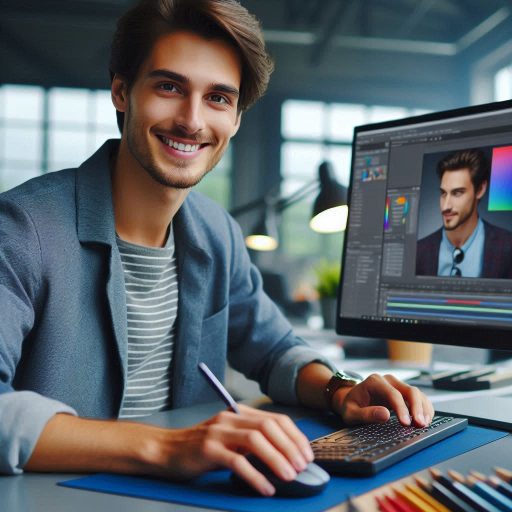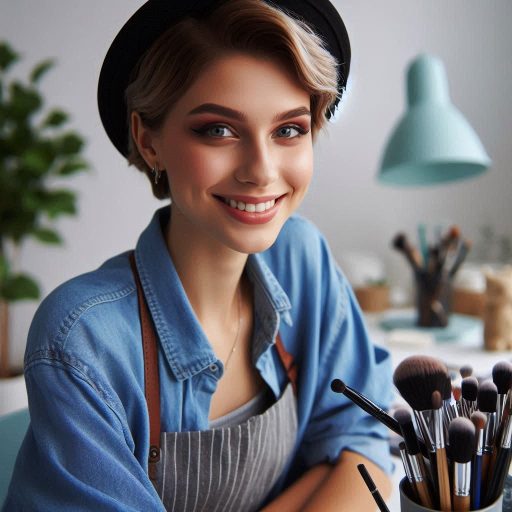Introduction
Collaborating with other artists is crucial in the creative industry.
It allows for networking opportunities and learning new skills.
Working together can lead to unique and innovative results.
Collaboration can also help artists gain exposure and reach new audiences.
It opens up doors for new projects and opportunities.
Overall, collaborating with other artists can enhance creativity and lead to greater success in the creative field.
Choose the Right Collaborators
Importance of selecting collaborators who share similar passions and work ethics
Selecting the right collaborators is crucial for a successful artistic project.
Begin by identifying individuals who share your passions and work ethics.
When collaborators are aligned with your vision and values, the creative process flows more smoothly.
Shared enthusiasm ensures that everyone remains motivated and committed to the project’s goals.
Equally important is diversity in backgrounds and styles.
Collaborating with artists from various disciplines or cultural backgrounds can infuse your project with unique perspectives.
This diversity helps challenge conventional ideas and push creative boundaries.
For instance, a painter and a digital artist working together might blend traditional and modern techniques in innovative ways.
Significance of diversity in backgrounds and styles to bring fresh perspectives to the project
Diverse styles and experiences enrich the artistic process.
They encourage experimentation and foster creativity by introducing new approaches and techniques.
This can lead to groundbreaking work that neither artist might have achieved independently.
Furthermore, working with people who have different skill sets and viewpoints can enhance problem-solving and creativity.
It’s also beneficial to assess potential collaborators’ previous work and reputation.
Look for those who have demonstrated reliability and professionalism in past projects.
Transform Your Career Today
Unlock a personalized career strategy that drives real results. Get tailored advice and a roadmap designed just for you.
Start NowThis helps ensure that your team will be productive and respectful of deadlines.
Finally, clear communication and mutual respect are essential.
Ensure that all collaborators understand and respect each other’s roles and contributions.
This prevents misunderstandings and promotes a harmonious working environment.
By carefully choosing collaborators who share your passion and bring diverse perspectives, you set the stage for a successful and rewarding artistic venture.
Read: The Influence of Art History on Modern Makeup
Communication is Key
The necessity of clear and open communication throughout the collaboration process
Effective communication is the foundation of successful collaborations.
Without clear and open communication, misunderstandings can arise, leading to delays and friction in the creative process.
It is essential to establish channels of communication early on and maintain them throughout the project.
Using tools like emails, zoom calls, and project management platforms can help streamline communication and ensure that all parties involved are on the same page.
Emails are great for documenting important discussions and decisions, while zoom calls provide a more personal touch, allowing for real-time feedback and brainstorming sessions.
Project management platforms, such as Trello or Asana, can help keep track of tasks, deadlines, and progress updates.
Using communication tools
By utilizing these communication tools, collaborators can stay organized and informed, reducing the likelihood of miscommunication or confusion.
It is crucial to establish clear expectations regarding communication frequency and methods from the outset.
This ensures that everyone is aware of how and when they can communicate with each other.
Regular check-ins and updates are also essential to keep the collaboration on track.
Setting up weekly or bi-weekly meetings can provide an opportunity to discuss progress, address any concerns, and make adjustments as needed.
Transparency and honesty in communication are key to building trust and fostering a positive working relationship.
In addition to formal communication channels, it is also important to maintain open lines of informal communication.
Showcase Your Business Today
Reach thousands of readers actively exploring professional services. Publish your business profile and grow your audience now.
Publish NowEncouraging casual conversations and sharing personal experiences can help build rapport and strengthen connections between collaborators.
This can lead to a more cohesive team dynamic and enhance creativity and productivity.
Overall, effective communication is a cornerstone of successful collaborations.
By emphasizing the importance of clear and open communication, utilizing the right tools, and setting expectations early on, artists can ensure that their collaborative projects are smooth, productive, and ultimately successful.
Set Clear Expectations
Importance of defining roles, deadlines, and goals at the beginning of the collaboration
Effective collaboration hinges on clear expectations. Start by defining roles clearly.
Each artist should understand their responsibilities.
This prevents overlap and confusion.
Assign tasks based on individual strengths and expertise.
Clearly defined roles help streamline efforts and enhance productivity.
Next, establish deadlines early in the process.
Deadlines create a sense of urgency and structure.
They ensure everyone knows when to deliver their part.
Without deadlines, projects can drift and miss key milestones.
Setting realistic deadlines helps manage expectations and keeps the project on track.
Goals should be outlined from the beginning.
Everyone involved must understand the project’s objectives.
Clear goals provide direction and focus.
They help align each artist’s efforts towards a common purpose.
Establishing measurable goals allows for tracking progress and adjusting as needed.
Creating a detailed project plan to keep everyone on track and accountable
Create a detailed project plan to maintain accountability.
A project plan should outline every phase of the work.
Include timelines, deliverables, and checkpoints.
This plan serves as a roadmap for the project.
It keeps everyone informed about their progress and responsibilities.
Regular check-ins based on this plan ensure that tasks are completed on time.
Encourage open communication throughout the project.
Discuss any changes or issues promptly.
This helps address concerns before they become major problems.
Open dialogue fosters a collaborative environment and strengthens team dynamics.
In summary, setting clear expectations is crucial for successful collaborations.
Define roles, set deadlines, and outline goals to keep the project focused and organized.
A detailed project plan ensures accountability and tracks progress.
Effective communication further enhances the collaboration process.
Read: Innovative Makeup Techniques and Trends
Foster a Creative Environment
Creating a supportive atmosphere builds trust and fosters open communication among collaborators.
Encouragement leads to higher levels of engagement and participation in the creative process.
Supportive environments result in a safe space for artists to express their ideas without fear of judgment.
Benefits of a Supportive Atmosphere
- Boosts morale and motivation within the team.
- Facilitates constructive feedback and idea-sharing.
- Enhances overall creativity and innovation.
Ways to Inspire Creativity and Brainstorm Ideas
- Hold regular brainstorming sessions to generate new concepts and approaches.
- Encourage thinking outside the box and exploring unconventional ideas.
- Create a visually stimulating environment with mood boards and inspiration walls.
- Engage in collaborative activities like art jams or improvisation exercises.
- Attend workshops or art exhibitions together to gain new perspectives and insights.
Read: How to Keep Up with SFX Industry Trends

Respect Each Other’s Vision
Importance of respecting each other’s artistic vision and ideas
In collaborative art projects, respecting each other’s artistic vision is crucial for success.
Each artist brings a unique perspective and style.
Showcase Your Business Today
Reach thousands of readers actively exploring professional services. Publish your business profile and grow your audience now.
Publish NowRecognizing and valuing these differences enriches the creative process.
When you respect another artist’s vision, you foster an environment of mutual trust.
This respect helps in creating a cohesive and harmonious final piece.
It ensures that every participant feels valued and understood, which can enhance creativity.
Encouraging constructive feedback and compromise to find a balance between different perspectives
Constructive feedback is essential in any collaborative effort.
Offer suggestions in a positive and respectful manner.
Focus on how changes can improve the overall project, rather than criticizing individual ideas.
This approach helps maintain a positive atmosphere and encourages open dialogue.
Compromise plays a vital role in blending diverse artistic perspectives.
Sometimes, differing views may lead to creative conflicts.
Finding a middle ground allows for the incorporation of various ideas, leading to innovative and well-rounded outcomes.
Compromise ensures that all voices are heard and contributes to a sense of shared ownership in the project.
Balancing different artistic perspectives requires flexibility and patience.
Be open to adjusting your ideas to accommodate others.
This willingness to adapt can lead to unexpected and inspiring results that might not have emerged otherwise.
In general, respecting each other’s artistic vision fosters collaboration and creativity.
Constructive feedback and compromise are key to integrating diverse perspectives.
By valuing each other’s contributions, you create a collaborative environment where all artists can thrive.
Read: Understanding the Art and Design of Makeup
Collaborate on Marketing and Promotion
When collaborating with other artists, it’s essential to remember that marketing and promotion play a crucial role in the success of the project.
Here are some tips on how to effectively collaborate on marketing and promotion:
Importance of promoting the collaborative project to maximize exposure
- Discuss with your collaborator the significance of promoting the project together.
- Make sure both parties are actively involved in promoting the work to reach a wider audience.
- Cross-promote each other’s work to leverage each other’s fan base and reach new audiences.
- Collaborate on creating promotional materials that showcase both artists’ work and talents.
- Utilize all available channels, including social media, websites, and other platforms, to promote the project.
Strategies for sharing the work on social media, websites, and other platforms
- Create a joint social media calendar outlining when and what content will be shared.
- Collaborate on creating engaging and visually appealing social media posts that highlight the collaboration.
- Encourage your followers to engage with and share the collaborative work on their social media channels.
- Tag each other in posts and use relevant hashtags to increase visibility and reach.
- Consider running targeted ads on social media platforms to promote the collaborative project to a wider audience.
- Feature the collaborative project on both artists’ websites and link back to each other’s platforms.
- Utilize email marketing to promote the project to your respective email lists and encourage sign-ups for updates.
- Engage with your audience by hosting live Q&A sessions or behind-the-scenes content related to the collaboration.
- Monitor the performance of your marketing efforts and adjust your strategy based on what is working best.
Overall, collaborating on marketing and promotion requires open communication, mutual effort, and a shared commitment to showcasing the collaborative project in the best possible light.
By working together to promote the work effectively, both artists can reap the benefits of increased exposure and recognition within their respective communities.
Learn from Each Other
Encouraging artists to see collaboration as an opportunity for growth and learning
Collaborating with other artists is not just about creating together, but also about learning from each other.
It’s essential to encourage artists to approach collaboration as a chance to grow and expand their skills.
Seeing collaboration as a learning opportunity can open up new avenues for creativity and provide fresh perspectives.
When artists work together, they can share their unique experiences and knowledge, which can help each other improve and evolve as artists.
Personal experiences of how collaborating with others has helped improve skills and broaden perspectives
Sharing personal experiences of how collaboration has positively impacted one’s artistic journey can inspire others to embrace working with other artists.
By hearing real stories of growth and development through collaboration, artists may be more inclined to seek out opportunities to collaborate.
Collaborating with other artists allows individuals to exchange ideas and techniques, ultimately leading to a broader skillset and a more diverse range of artistic tools.
Learning from each other can spark creativity and innovation, pushing artists to explore new possibilities and push their boundaries.
When artists come together to collaborate, they have the chance to learn from each other’s strengths and areas for growth.
By sharing their experiences and skills, artists can support one another in areas where they may need guidance or inspiration.
In a collaborative setting, artists can provide constructive feedback and constructive criticism, helping each other evolve and refine their craft.
This mutual learning process benefits everyone involved and fosters a supportive and enriching creative environment.
Overall, learning from each other in a collaborative setting can lead to personal and artistic growth.
Encouraging artists to see collaboration as an opportunity to expand their skills and perspectives can enhance their artistic journey and contribute to a more vibrant and interconnected artistic community.
Reflect on the Experience
The significance of reflecting on the collaboration process and outcomes
- Reflecting helps artists understand what worked well and what didn’t.
- It allows for improvements in communication and workflow for future collaborations.
- Artists can pinpoint areas of growth and development in their artistic process.
- Reflecting helps in building stronger relationships with other artists.
Encouraging artists to celebrate successes and learn from challenges to improve future collaborations
- Celebrating successes boosts morale and confidence for artists.
- Learning from challenges leads to growth and resilience in the face of obstacles.
- It fosters a culture of continuous improvement and innovation in collaborations.
- Artists can develop strategies to overcome similar challenges in the future.
Conclusion
Collaborating with other artists can be a rewarding and enriching experience.
By working together, artists can share ideas, inspiration, and techniques to create something truly unique.
Communication and mutual respect are key elements to successful collaborations.
Showcase Your Business Today
Reach thousands of readers actively exploring professional services. Publish your business profile and grow your audience now.
Publish NowRemember to establish clear goals and expectations at the start of the collaboration to avoid misunderstandings.
Be open to feedback and suggestions from your fellow artists, as this can help elevate the final result of your joint project.
Embrace the different perspectives and styles each artist brings to the table, as it can lead to innovative and unexpected creations.
As artists, we should constantly seek out collaboration opportunities to continue growing and evolving in our craft.
By working with others, we can push our boundaries, learn new skills, and expand our creative horizons.
Let’s embrace teamwork and shared creativity as a way to enhance our artistic journey.
[E-Books for Sale]
The Big Book of 500 High-Paying Jobs in America: Unlock Your Earning Potential
$19.99 • 500 High-Paying Jobs • 330 pages
Explore 500 high-paying jobs in America and learn how to boost your career, earn more, and achieve success!
See All 500 High-Paying Jobs of this E-Book
1001 Professions Without a Degree: High-Paying American Jobs You Can Start Now
$19.99 • 1001 Professions Without a Degree • 174 pages
Discover 1001 high-paying jobs without a degree! Unlock career tips, skills, and success strategies for just $19.99!




